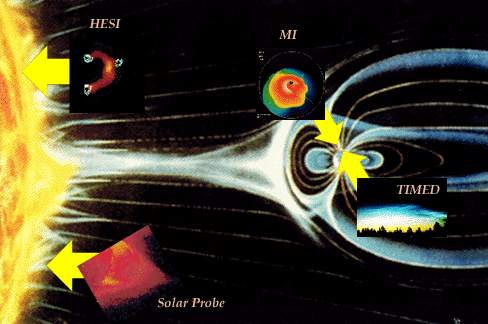


The near-term program focuses on the weakest links in our knowledge of the Solar Connections chain.
The most effective use of resources requires that science programs become more selective and efficient, focus on questions of immediate impact on NASA's space science objectives, and have a strong component addressing societal needs. The near-term program in Solar Connections focuses on Sun-Earth relationships.
We propose an integrated, balanced flight program that builds on existing spacecraft, together with three new, small, high-technology spacecraft called Solar-Terrestrial Probes and an innovative Solar Probe mission undertaken jointly with Russia. The program will make a concerted attack on the problem of solar activity and how it impacts the terrestrial environment, thereby focusing on the weakest links in the solar connections chain.
The Solar-Terrestrial Probes are new, low-cost imaging spacecraft that will study the mesosphere-thermosphere, high-energy aspects of solar flares, and the magnetosphere, in a coordinated, phased effort. Each component of this program has evolved, scientifically and technologically, from refined studies involving all of the space physics community and are considered the best missions for addressing the most important unanswered questions in the Solar Connections chain. The Solar-Terrestrial Probes are TIMED (Thermosphere, Ionosphere, Mesosphere Energetics and Dynamics), HESI (High-Energy Solar Imager), and MI (Magnetospheric Imager).
Solar Probe, a mission to send instruments closer to the surface of the Sun than ever before attempted, is a US-Russian space cooperation feature of Sun-Earth Connections, and is an integral part of the US-Russia program called Fire and Ice.

Click here for a larger, JPEG representation of the figure at the top of the page.

Solar Connections: A Science Initiative for NASA Space Physics